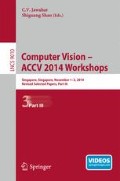Abstract
Multi-target tracking of pedestrians is a challenging task due to uncertainty about targets, caused mainly by similarity between pedestrians, occlusion over a relatively long time and a cluttered background. A usual scheme for tackling multi-target tracking is to divide it into two sub-problems: data association and trajectory estimation. A reasonable approach is based on joint optimization of a discrete model for data association and a continuous model for trajectory estimation in a Markov Random Field framework. Nonetheless, usual solutions of the data association problem are based only on location information, while the visual information in the images is ignored. Visual features can be useful for associating detections with true targets more reliably, because the targets usually have discriminative features. In this work, we propose a combination of position and visual feature information in a discrete data association model. Moreover, we propose the use of group Lasso regularization in order to improve the identification of particular pedestrians, given that the discriminative regions are associated with particular visual blocks in the image. We find promising results for our approach in terms of precision and robustness when compared with a state-of-the-art method in standard datasets for multi-target pedestrian tracking.
Access this chapter
Tax calculation will be finalised at checkout
Purchases are for personal use only
References
Benfold, B., Reid, I.: Stable multi-target tracking in real-time surveillance video. In: Conference on Computer Vision and Pattern Recognition (CVPR), pp. 3457–3464 (2011)
Bar-Shalom, Y., Fortmann, T.: Tracking and Data Association. Academic Press, Boston (1988)
Liu, J., Carr, P., Collins, R., Liu, Y.: Tracking sports players with context-conditioned motion models. In: Conference on Computer Vision and Pattern Recognition (CVPR), pp. 1–8 (2013)
Liu, J., Chu, M., Liu, J., Reich, J., F.Zhao: Distributed state representation for tracking problems in sensor networks. In: Third International Symposium on Information Processing in Sensor Networks, pp. 234–242 (2004)
Andriyenko, A., Schindler, K., Roth, S.: Discrete-continuous optimization for multi-target tracking. In: Conference on Computer Vision and Pattern Recognition, pp. 1926–1933 (2012)
Grabner, H., Leistner, C., Bischof, H.: Semi-supervised on-line boosting for robust tracking. In: Forsyth, D., Torr, P., Zisserman, A. (eds.) ECCV 2008, Part I. LNCS, vol. 5302, pp. 234–247. Springer, Heidelberg (2008)
Collins, J., Uhlmann, J.: Efficient gating in data association with multivariate gaussian distributed states. IEEE Trans. Aerosp. Electron. Syst. 28, 909–916 (1992)
Kuo, C.H., Huang, C., Nevatia, R.: Multi-target tracking by on-line learned discriminative appearance models. In: Conference on Computer Vision and Pattern Recognition (CVPR), pp. 685–692 (2010)
Berclaz, J., Fleuret, F., Turetken, E., Fua, P.: Multiple object tracking using k-shortest paths optimization. IEEE Trans. Pattern Anal. Mach. Intell. (TPAMI) 33, 1806–1819 (2011)
Yang, B., Nevatia, R.: An online learned crf model for multi-target tracking. In: Conference on Computer Vision and Pattern Recognition (CVPR), pp. 2034–2041 (2012)
Butt, A.A., Collins, R.T.: Multiple target tracking using frame triplets. In: Lee, K.M., Matsushita, Y., Rehg, J.M., Hu, Z. (eds.) ACCV 2012, Part III. LNCS, vol. 7726, pp. 163–176. Springer, Heidelberg (2013)
Hofmann, M., Haag, M., Rigoll, G.: Unified hierarchical multi-object tracking using global data association. In: International Workshop on Performance Evaluation of Tracking and Surveillance (PETS), pp. 16–18 (2013)
Meier, L., Van De Geer, S., Bühlmann, P.: The group lasso for logistic regression. J. Roy. Stat. Soc.: Ser. B (Statistical Methodology) 70, 53–71 (2008)
Simon, N., Friedman, J., Hastie, T., Tibshirani, R.: A sparse-group lasso. J. Comput. Graph. Stat. 22, 231–245 (2013)
Li, S.: Markov Random Field Modeling in Image Analysis. Springer-Verlag New York Inc., Secaucus (2001)
Lee, S.I., Lee, H., Abbeel, P., Ng, A.: Efficient l1 regularized logistic regression. In: National Conference on Artificial Intelligence, pp. 1–9 (2006)
Liu, J., Ji, S., Ye, J.: SLEP: Sparse learning with efficient projections, vol. 1813. Arizona State University (2009)
Andriluka, M., Roth, S., Schiele, B.: Discriminative appearance models for pictorial structures. Int. J. Comput. Vis. 99, 259–280 (2012)
Dalal, N., Triggs, B.: Histograms of oriented gradients for human detection. In: Conference on Computer Vision and Pattern Recognition, pp. 886–893 (2005)
Stiefelhagen, R., Bernardin, K., Bowers, R., Garofolo, J.S., Mostefa, D., Soundararajan, P.: The CLEAR 2006 evaluation. In: Stiefelhagen, R., Garofolo, J.S. (eds.) CLEAR 2006. LNCS, vol. 4122, pp. 1–44. Springer, Heidelberg (2007)
Acknowledgement
This work was funded by FONDEF grant D10I1054.
Author information
Authors and Affiliations
Corresponding author
Editor information
Editors and Affiliations
A Derivation of Gradient and Hessian of Unregularized Energy Function
A Derivation of Gradient and Hessian of Unregularized Energy Function
In our method, we must minimize the unregularized version of energy function given by Eq. A.3, this problem is given by:
By calling the gradient \(\nabla _{w_l} E_{PL:d}^{T(u)} (w_l)\) as \(G(w_l)\), this term is calculated as following:
We call the Hessian \(H_{w_l} (E_{PL:d}^{T(u)} (w_l))\) as \(H(w_l)\) and calculate it from gradient expression as following:
With both terms, we can optimize the Eq. A.1 with Newton’s method in order to estimate the optimal value of weight vector w.
Rights and permissions
Copyright information
© 2015 Springer International Publishing Switzerland
About this paper
Cite this paper
Peralta, B., Soto, A. (2015). Multi-target Tracking with Sparse Group Features and Position Using Discrete-Continuous Optimization. In: Jawahar, C., Shan, S. (eds) Computer Vision - ACCV 2014 Workshops. ACCV 2014. Lecture Notes in Computer Science(), vol 9010. Springer, Cham. https://doi.org/10.1007/978-3-319-16634-6_49
Download citation
DOI: https://doi.org/10.1007/978-3-319-16634-6_49
Published:
Publisher Name: Springer, Cham
Print ISBN: 978-3-319-16633-9
Online ISBN: 978-3-319-16634-6
eBook Packages: Computer ScienceComputer Science (R0)

